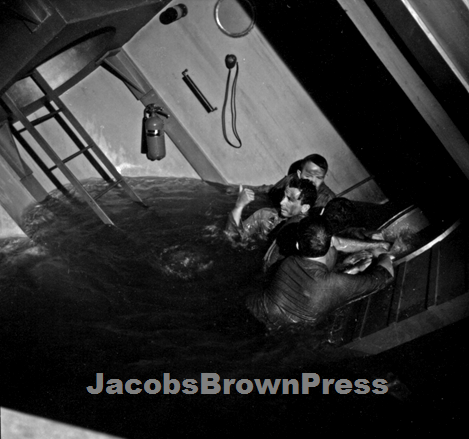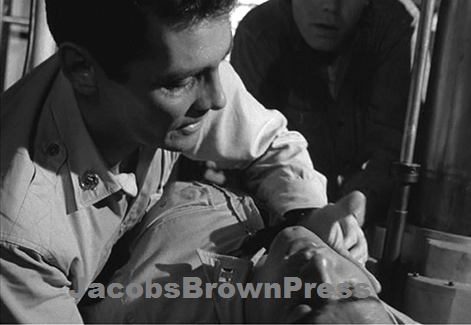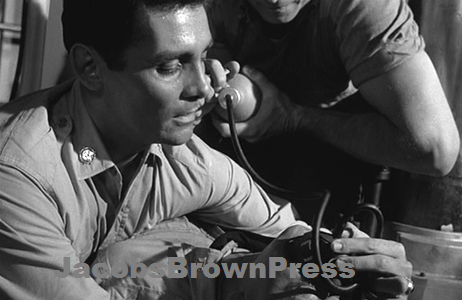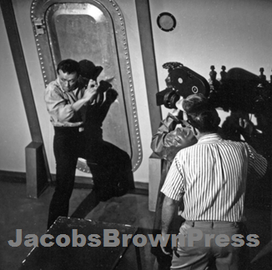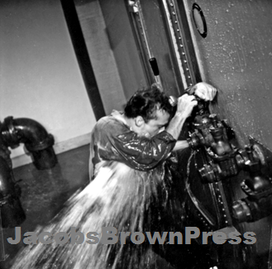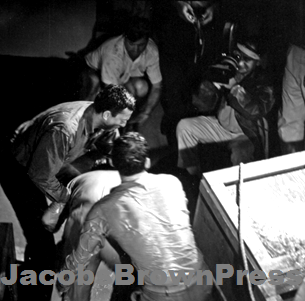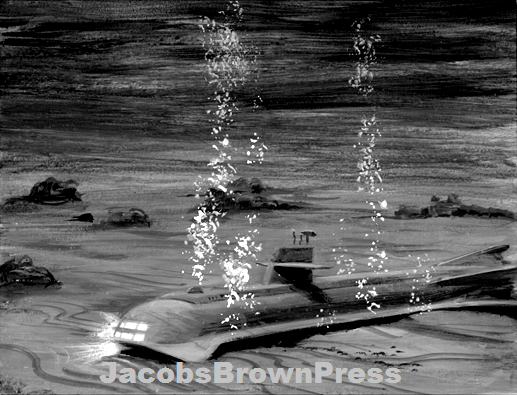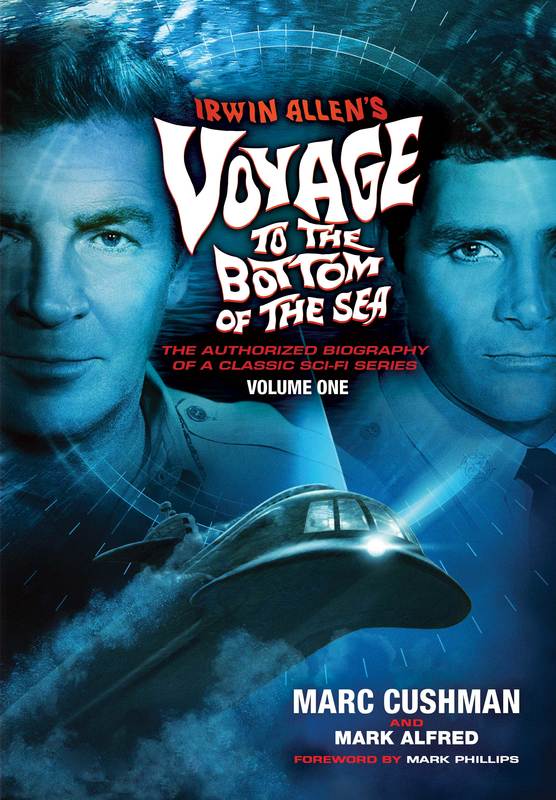Season 1 - Episode 12: “Submarine Sunk Here”
(Prod. #7212; first aired Monday, November 16, 1964)
Written by William Tunberg
Directed by Leonard Horn
Produced by Irwin Allen
Story Editor: William Welch; Associate Producer: Joseph Gantman
Assistant Story Editor: Al Gail
Co-starring Carl Reindel, Eddie Ryder, Robert Doyle, Wright King
Synopsis:
From the Voyage to the Bottom of the Sea show files (Irwin Allen Papers Collection):
|
The Seaview, damaged by a mine explosion as it enters an uncharted minefield, has sunk to the bottom. There is only enough air to last 8 hours and the only hope of escape is the diving bell which is presently undergoing repairs. The problem is: Can the men survive until help arrives?
|
Sound Bites:
Harker: “I couldn't hold him, sir. I just couldn’t hold him. He’s still down there.” Nelson: “Dog the hatch.” Harker: “He’s still alive down there.” Nelson: “Dog the hatch! That’s an order.”
Nelson: “Engine room, Nelson, report. Engine room, this is Nelson, report your condition!” Harker: “They’re all dead. They’re dead. Just floating out there. Dead.”
Collins: “Give it to us straight, sir, can we get out?” Nelson: “Well, we’ve got one chance. It’s a pretty good one. Our position is known; we’re not far from New London. When the radio quit, the Coast Guard must’ve started a search for us. They can’t fail to see our marker buoy.” Collins: “Suppose the Coast Guard don’t find us?” Nelson: “Suppose you’re crossing the street in Los Angeles a month from now and a car hits you?”
Nelson: “Engine room, Nelson, report. Engine room, this is Nelson, report your condition!” Harker: “They’re all dead. They’re dead. Just floating out there. Dead.”
Collins: “Give it to us straight, sir, can we get out?” Nelson: “Well, we’ve got one chance. It’s a pretty good one. Our position is known; we’re not far from New London. When the radio quit, the Coast Guard must’ve started a search for us. They can’t fail to see our marker buoy.” Collins: “Suppose the Coast Guard don’t find us?” Nelson: “Suppose you’re crossing the street in Los Angeles a month from now and a car hits you?”
Assessment:
Voyage historian Mike Bailey said, “This is one of those Voyage episodes where you can lift virtually any frame from the film, and you’ve got a terrific still shot, so finely executed is the camera work. It was perhaps Voyage’s reputation as a kid’s show based on critical reaction to the pilot that kept this episode and/or Richard Basehart from being nominated for an Emmy. I don’t believe it’s too far off the beam to suggest that it and he are that good. The entire cast shines.” (vttbots.com)
Indeed! “Submarine Sunk Here” is just about as taunt as a drama gets. The episode’s intensity is only increased by the fact that Voyage’s first season was black-and-white. The cinematography is crisp, and suitably dark. The tension is so thick you can cut it with a knife. Superb in nearly all ways.
Indeed! “Submarine Sunk Here” is just about as taunt as a drama gets. The episode’s intensity is only increased by the fact that Voyage’s first season was black-and-white. The cinematography is crisp, and suitably dark. The tension is so thick you can cut it with a knife. Superb in nearly all ways.
Script:
William Tunberg’s writers contract: July 17, 1964.
Tunberg’s treatment, and 1st and 2nd draft teleplays: Date unknown.
Mimeo Department’s reformatted Shooting Final teleplay: September 15.
Revised Shooting Final teleplay, by William Welch or Al Gail (dark green pages): September 16.
Page revisions by writing staff (on pink paper): September 17.
Page revisions (on gold paper): September 17.
Page revisions (on blue paper): September 21.
Page revisions (on light green paper): September 22.
Tunberg’s treatment, and 1st and 2nd draft teleplays: Date unknown.
Mimeo Department’s reformatted Shooting Final teleplay: September 15.
Revised Shooting Final teleplay, by William Welch or Al Gail (dark green pages): September 16.
Page revisions by writing staff (on pink paper): September 17.
Page revisions (on gold paper): September 17.
Page revisions (on blue paper): September 21.
Page revisions (on light green paper): September 22.
William Tunberg was 50 and had written the screenplay for the 1957 film Old Yeller, as well as the 1963 Disney Western Savage Sam, which co-starred Marta Kristen (soon to be cast in Lost in Space). This was his only script for Voyage and Irwin Allen.
After reading one of the early drafts of the script, Irwin Allen sent his notes to associate producer Joseph Gantman, script editor William Welch, and associate script editor Al Gail:
After reading one of the early drafts of the script, Irwin Allen sent his notes to associate producer Joseph Gantman, script editor William Welch, and associate script editor Al Gail:
|
Page 1, Sc. 1: Change Ward Room to Observation Nose – (What do we see out the front window?). …
Page 8, Sc. 10: Change “door” to “hatch.” … Page 18, Sc. 33: Phone going dead so fast is phony. Page 19, Sc. 35: Bishop’s first speech is peevish – should be hard and tough. Collins would never say what he does. Page 21, Sc. 35: Baine’s third speech – Change “If we save” to “If we hope to save”. Page 22, Sc. 36: Crane’s third speech – Re-write! … Page 27, Sc. 40: Crane’s second speech – Change “lately” to “within the hour!” Page 32: Act Two does not have an exciting ending. Page 33: Why does Morton speak “(absently)”. He should be vital, alive, anxious! Page 34 & 35: All the dialogue sounds like Mrs. Minerva’s finishing school instead of a race against death to save a friend. … Page 42: Bishop’s first speech – Typo – Bishop’s second speech – What does “only those six” mean? Page 51 thru 53: Wouldn’t Nelson bring a couple of tanks of oxygen? Why doesn’t someone in the submarine pound back on the hull? SUMMATION:
|
In time, the script became a taut, suspenseful episode. It just took a bit of rewriting to get there, matched with effective direction, production and, especially, dynamic acting.
Production:
(Filmed September 17-25; 7 days)
(Budget: $122,323)
(Filmed September 17-25; 7 days)
(Budget: $122,323)
There were no stars hired for “Submarine Sunk Here,” but the episode did feature some very familiar faces from television at this time.
In the order of their “co-starring” billing:
Carl Reindel played Evans. He was 29, and had been working regularly in television, with multiple appearances on Gunsmoke and Perry Mason, among other series. His contract was also for $1,000 for up to six days.
Eddie Ryder played Harker. He was 41, and had been a regular on two series: The Dennis O’Keefe Show (1959-60) and Dr. Kildare (1961-65). He also received $1,000 for a six-day contract.
Robert Doyle was 26 when he played Blake. He had appeared on 12 O’Clock High, The Fugitive, and in two episodes of The Outer Limits, as well as series such as Stoney Burke and The Untouchables. He was paid $1,000 for up to six days work. He would return to the Seaview, in the second-season episode “… And Five of Us Are Left.”
Wright King played Dr. Baines. He was 41, and, from 1959-1960, had been Steve McQueen’s sidekick during the final season of Wanted: Dead or Alive. He had also been a regular in the 1953-54 sci-fi series, Johnny Jupiter. His contract was for $375 for a single day’s work. He ended up staying four days.
Also in the cast:
George Lindsey, the future Goober on The Andy Griffith Show, played Collins. In his pre-Mayberry days, he was paid $750 for five days work.
Paul Comi was assigned the role of Bishop, and budgeted at $300 for one day before the cameras. He was 32, and had been a regular on the 1960-61 Western series, Two Faces West, as well as the skydiver series Ripcord, airing from 1961 through ’63. Comi had also appeared in three episodes of The Twilight Zone, and shortly after this Voyage would go into space as Styles, the bigoted navigator in the Star Trek episode “Balance of Terror.”
Production began on Thursday, September 17, 1964, at the studio’s “Mill Area” and the backlot “Moat.” The Mill, where the props and sets were made, served as the location for the “Ext. Repair Shed" and "Ext. Hospital",
In the order of their “co-starring” billing:
Carl Reindel played Evans. He was 29, and had been working regularly in television, with multiple appearances on Gunsmoke and Perry Mason, among other series. His contract was also for $1,000 for up to six days.
Eddie Ryder played Harker. He was 41, and had been a regular on two series: The Dennis O’Keefe Show (1959-60) and Dr. Kildare (1961-65). He also received $1,000 for a six-day contract.
Robert Doyle was 26 when he played Blake. He had appeared on 12 O’Clock High, The Fugitive, and in two episodes of The Outer Limits, as well as series such as Stoney Burke and The Untouchables. He was paid $1,000 for up to six days work. He would return to the Seaview, in the second-season episode “… And Five of Us Are Left.”
Wright King played Dr. Baines. He was 41, and, from 1959-1960, had been Steve McQueen’s sidekick during the final season of Wanted: Dead or Alive. He had also been a regular in the 1953-54 sci-fi series, Johnny Jupiter. His contract was for $375 for a single day’s work. He ended up staying four days.
Also in the cast:
George Lindsey, the future Goober on The Andy Griffith Show, played Collins. In his pre-Mayberry days, he was paid $750 for five days work.
Paul Comi was assigned the role of Bishop, and budgeted at $300 for one day before the cameras. He was 32, and had been a regular on the 1960-61 Western series, Two Faces West, as well as the skydiver series Ripcord, airing from 1961 through ’63. Comi had also appeared in three episodes of The Twilight Zone, and shortly after this Voyage would go into space as Styles, the bigoted navigator in the Star Trek episode “Balance of Terror.”
Production began on Thursday, September 17, 1964, at the studio’s “Mill Area” and the backlot “Moat.” The Mill, where the props and sets were made, served as the location for the “Ext. Repair Shed" and "Ext. Hospital",
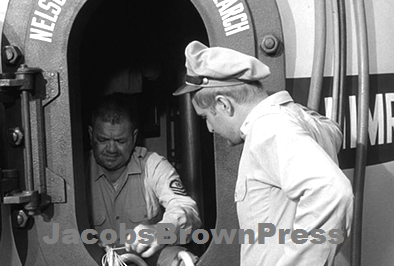 Henry Kulky and Robert Dowdell on the first day of production, at the Moat location.
Henry Kulky and Robert Dowdell on the first day of production, at the Moat location.
This location served for New London, Connecticut, home of the U.S. Coast Guard Academy. After rehearsals, blocking, and lighting set-ups, filming began at the outdoor locations at 10:10 a.m. A trip to the Moat provided the location needed for “Ext. Buoy” and “Ext. Salvation Vessel.” And then the company moved to Stage B to film the scenes involving the “Int. Escape Bell.” The last shot was taken at 7:45 p.m.
Day 2, Friday. They filmed on Stage B and the Int. Observation Nose, as well as starting work in the Int. Control Room. Outside the bay windows, the underwater minefield footage from the Voyage feature film gets a good dusting off. It’s augmented with many additional shots of exploding mines, which were not from the film. The company filmed from 8:30 a.m. to 7:05 p.m.
Del Monroe told interviewer Mark Phillips, “One of the main criticisms of the pilot, ‘Eleven Days to Zero,’ was that these were plastic characters. And that was true. Many of the scripts were like that because Irwin wanted an action-adventure show. The relationships between the characters came out through the dedication of the actors. We were always trying to find ways to make the show believable, which is the job of an actor anyway.” (DM-SLY98)
With this episode, all the components clicked to form a top-notch Voyage.
Day 3, Monday, September 21. The company spent the entire day in the ship’s Control Room, with the usual 6:30 a.m. call time, and on set by 8. Since the lighting set-up was in place from the day before, the camera rolled at 8:05 a.m.
Derrik Lewis, present here in his recurring role as Lt. O’Brien, said, “‘Submarine Sunk Here’ was probably the standout of my work on that show. You wait to get something to do on these things, and the hardest thing in Hollywood is to only have a few lines. At least in a play you can have a lot of dialogue. But a lot of the time in TV episodics you just have a few single lines, and it’s harder. But when you’re given something to do, then you have a chance to reach for something. The scene where O’Brien is choking, for instance, now that was wonderful. I can remember Leonard walking us through – a little bit of rehearsal on what was going to happen – and then, when the cameras were rolling, we were on our own. And I liked that; I’ve always liked not knowing exactly what was going to happen. And everybody went right with it. I mean, David was wonderful, in how he jumped in at that point when O’Brien starting choking. He was an ‘actor’ in every sense of the word. That was the thing – these people were
Del Monroe told interviewer Mark Phillips, “One of the main criticisms of the pilot, ‘Eleven Days to Zero,’ was that these were plastic characters. And that was true. Many of the scripts were like that because Irwin wanted an action-adventure show. The relationships between the characters came out through the dedication of the actors. We were always trying to find ways to make the show believable, which is the job of an actor anyway.” (DM-SLY98)
With this episode, all the components clicked to form a top-notch Voyage.
Day 3, Monday, September 21. The company spent the entire day in the ship’s Control Room, with the usual 6:30 a.m. call time, and on set by 8. Since the lighting set-up was in place from the day before, the camera rolled at 8:05 a.m.
Derrik Lewis, present here in his recurring role as Lt. O’Brien, said, “‘Submarine Sunk Here’ was probably the standout of my work on that show. You wait to get something to do on these things, and the hardest thing in Hollywood is to only have a few lines. At least in a play you can have a lot of dialogue. But a lot of the time in TV episodics you just have a few single lines, and it’s harder. But when you’re given something to do, then you have a chance to reach for something. The scene where O’Brien is choking, for instance, now that was wonderful. I can remember Leonard walking us through – a little bit of rehearsal on what was going to happen – and then, when the cameras were rolling, we were on our own. And I liked that; I’ve always liked not knowing exactly what was going to happen. And everybody went right with it. I mean, David was wonderful, in how he jumped in at that point when O’Brien starting choking. He was an ‘actor’ in every sense of the word. That was the thing – these people were
all trained actors, not just a character, or a celebrity, or a pretty face – and that’s what was exciting about working on that show.” (DL-AI18)
The company stopped filming at 7 p.m. The second episode of Voyage to air, “City Beneath the Sea,” had its premiere broadcast on ABC this night, at 7:30 p.m.
The company stopped filming at 7 p.m. The second episode of Voyage to air, “City Beneath the Sea,” had its premiere broadcast on ABC this night, at 7:30 p.m.
|
Days 4 and 5. Tuesday was another day spent in the Control Room, with production then moving to the Sickbay set, the ship’s corridors, and a set area called “Hatch to Turbine Tunnel.” They filmed until 7:15 p.m., then returned on Wednesday, filming all the “water sets,” including Int. Small Compartment, Int. Turbine Tunnel, Int. Storage Locker, and Int. Brig … all flooded, with the production crew as waterlogged as the actors. The men had been in the water from 8 a.m. to 6:45 p.m. Actor George Lindsey said, “It was one of the best shows they ever did. I was cold and wet all of the time, but it was a fun show. Richard Basehart was a real pro.” (GL-SFTS2) Days 6 and 7. Thursday and Friday, were drier days, working in the Int. Crew Quarters, Int. Missile Room (at Mini Sub), and numerous sections of ship’s corridors. By 7:30 p.m. on Friday, after a seventh full day of production, this difficult, effects-driven story had wrapped. Money was saved by some serious “recycling” of footage – the mine field scene, prompting the destruction of the Mini Sub. However, some shots of the chain reaction of underwater mines exploding did not appear in the 1961 Voyage feature film. |
|
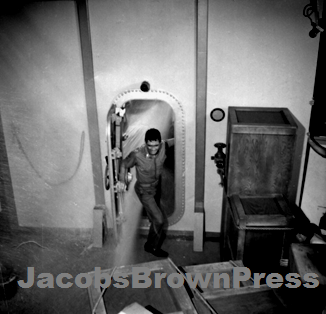 David Hedison jumps in. For the flooding scenes, multiple cameras – including hand-held models – were rolling to catch different angles in as few takes as possible.
David Hedison jumps in. For the flooding scenes, multiple cameras – including hand-held models – were rolling to catch different angles in as few takes as possible.
After the excellent work involved in making “Submarine Sunk Here,” cast and production crew deserved a rest, and they would get one – two weeks off for the industry-wide hiatus known as the Labor Day Break. During this interruption in production, TV series often sent their stars on the road, promoting the premieres of the Fall TV season. Richard Basehart, in particular, made the rounds, granting interviews to local newspaper writers in several U.S. cities. Meanwhile, the production people could rest after several months of working 12-hour-plus days, five days a week. The editors would have time to catch up on making their deliveries to the network. And, finally, with the premiere of the series, and the early ratings reports, producers would have an idea as to whether they might expect to see a midseason renewal and, therefore, need more scripts.
Release / Reaction:
(ABC premiere broadcast: 11/16/64; network repeat airing: 5/24/65)
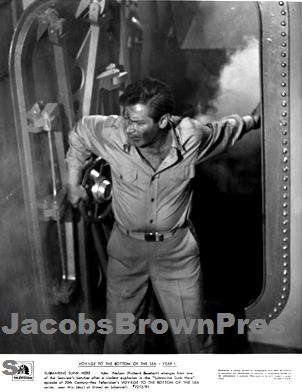
“Submarine Sunk Here” was the twelfth episode to film, the tenth to air on ABC. It was well liked and given a repeat broadcast by the network. When it premiered, “Baby Love” by the Supremes was the song playing the most on the radio, and Roustabout, starring Elvis Presley, was No. 1 in the movie houses. And you could buy a can of Coke for 12 cents.
Steven Scheuer of syndicated “TV Key,” from November 15, 1964, and printed in Indiana’s Kokomo Tribune, liked what he saw:
|
Best in weeks. Less stress on visual gimmicks and more on plot as the Seaview sinks to a level of 600 feet and is unable to surface. The rescue scenes are very well handled.
|
Over at “TV Scout,” syndicated to other newspapers on November 16, such as Arizona’s Tucson Daily Courier, Joan Crosby said:
|
Voyage to the Bottom of the Sea is REALLY a voyage to the bottom of the sea in “Submarine Sunk Here.” Though circumstances under which the Seaview gets itself damaged and sunk in the middle of an uncharted mine field are completely incredible, once you accept the situation it’s nail-chewing time. Can the ship and its men escape, and how, particularly since everything seems to be fouling up, the air is running out and the men are at each other’s throats?
|
A TV series involving a submarine might have been expected to do at least one episode like this, which exploited the limitations of the craft’s artificial environment. Audience support seemed clear. According to A.C. Nielsen, the ratings from November 16, 1964 gave Voyage the win for its time period:
Nielsen ratings report from Nov. 16, 1964: Rating: Share:
7:30 – 8 p.m.:
ABC: Voyage to the Bottom of the Sea 23.6 35.1%
CBS: To Tell the Truth 17.0 25.3%
NBC: 90 Bristol Court: Karen 14.2 21.1%
8 – 8:30 p.m.
ABC: Voyage to the Bottom of the Sea 24.7 36.0%
CBS: I’ve Got a Secret 16.4 23.9%
NBC: 90 Bristol Court: Harris Against the World 14.8 21.5%
7:30 – 8 p.m.:
ABC: Voyage to the Bottom of the Sea 23.6 35.1%
CBS: To Tell the Truth 17.0 25.3%
NBC: 90 Bristol Court: Karen 14.2 21.1%
8 – 8:30 p.m.
ABC: Voyage to the Bottom of the Sea 24.7 36.0%
CBS: I’ve Got a Secret 16.4 23.9%
NBC: 90 Bristol Court: Harris Against the World 14.8 21.5%
The day after “Submarine Sunk Here” first aired, it was announced that Voyage had been picked up for broadcast in Canada. It was also announced that the series, along with To Tell the Truth and I’ve Got a Secret on CBS, had knocked off the NBC competition. According to a UPI story:
|
The failure of Harris Against the World is especially hard for its star Jack Klugman who moved from New York complete with family to appear in the series. He’ll probably move back East.
|
Klugman would return west in time. He’d have better luck in 1970 with his second series, The Odd Couple, followed in 1976 by a third, Quincy, M.E.
Voyage to the Bottom of the Sea ® and its characters and designs are © Legend Pictures, LLC, and
licensed by Synthesis Entertainment. All rights reserved.
This book is a work of journalism, protected under the First Amendment, with information presented under “fair use” guidelines.
All photographs, script excerpts, artwork, contractual information and transcripts taken from the Irwin Allen Archives are © Legend Pictures, LLC and used with permission, except where otherwise noted.
“Voyage to the Bottom of the Sea” ® and its characters, indicia and designs are trademarks of Legend Pictures, LLC.
“THE FANTASY WORLDS OF IRWIN ALLEN” ® is a registered trademark of Synthesis Entertainment. All rights reserved.
